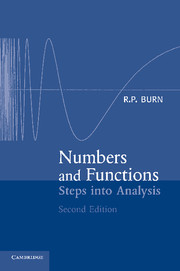Book contents
- Frontmatter
- Contents
- Preface to first edition
- Preface to second edition
- Glossary
- PART I NUMBERS
- PART II FUNCTIONS
- 6 Functions and continuity: neighbourhoods, limits of functions
- 7 Continuity and completeness: functions on intervals
- 8 Derivatives: tangents
- 9 Differentiation and completeness: Mean Value Theorems, Taylor's Theorem
- 10 Integration: the Fundamental Theorem of Calculus
- 11 Indices and circle functions
- 12 Sequences of functions
- Appendix 1 Properties of the real numbers
- Appendix 2 Geometry and intuition
- Appendix 3 Questions for student investigation and discussion
- Bibliography
- Index
6 - Functions and continuity: neighbourhoods, limits of functions
Published online by Cambridge University Press: 06 July 2010
- Frontmatter
- Contents
- Preface to first edition
- Preface to second edition
- Glossary
- PART I NUMBERS
- PART II FUNCTIONS
- 6 Functions and continuity: neighbourhoods, limits of functions
- 7 Continuity and completeness: functions on intervals
- 8 Derivatives: tangents
- 9 Differentiation and completeness: Mean Value Theorems, Taylor's Theorem
- 10 Integration: the Fundamental Theorem of Calculus
- 11 Indices and circle functions
- 12 Sequences of functions
- Appendix 1 Properties of the real numbers
- Appendix 2 Geometry and intuition
- Appendix 3 Questions for student investigation and discussion
- Bibliography
- Index
Summary
Preliminary activity: make sure that you have access to graph-drawing facilities on a computer or graphic calculator, and that you can use these facilities with confidence.
Preliminary reading: Leavitt ch. 1.
Concurrent reading: Swann and Johnson, Hart, Reade, Smith, Spivak chs 4, 5, 6.
Functions
When you read or hear the phrase ‘the function f(x)’, what comes to your mind? Perhaps a formula, perhaps a graph.
1 Write down what x can stand for, and what is meant by f, in the expression f(x). Compare your answer with the one in the summary on page 145.
We will introduce some special vocabulary in order to be clear what we mean when talking about functions.
The domain of a function
If f(x) = x2 and the values of x are 0, ±1, ±2, ±3, …, ±n, …, then the values of f(x) are 0, 1, 4, 9, …, n2, …. The set of possible values of x is called the domain of the function. When we say that x is a variable, we mean that the symbol x is being used to denote any member of the domain of a function. When the possible values of x are real numbers, the function is called a function of a real variable.
- Type
- Chapter
- Information
- Numbers and FunctionsSteps into Analysis, pp. 143 - 181Publisher: Cambridge University PressPrint publication year: 2000



